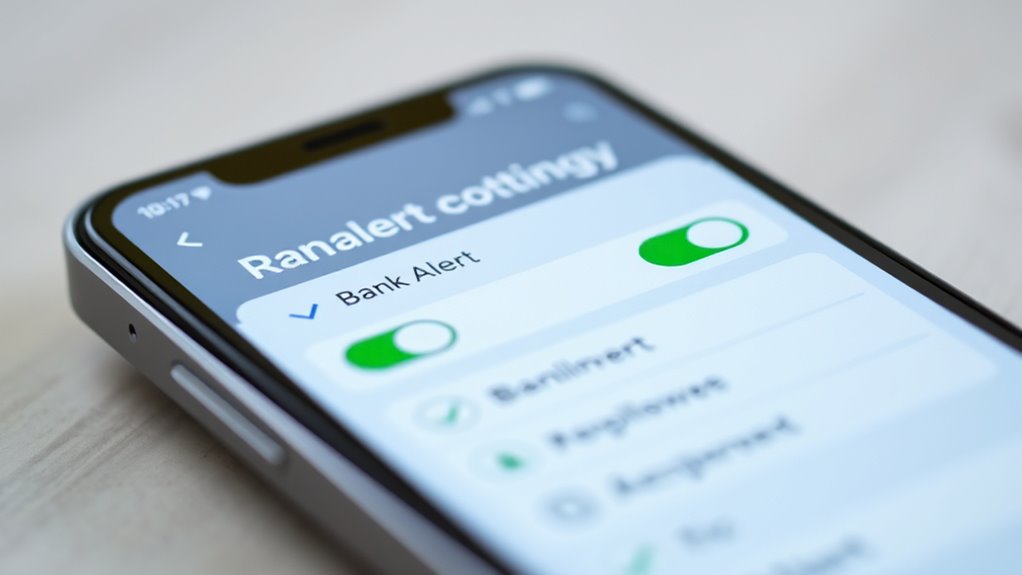Activating your bank’s alert system is one of the simplest yet most effective ways to stop scams before they escalate. By setting up notifications for unusual transactions, large withdrawals, or login attempts, you stay informed instantly and can act fast—freezing accounts or verifying activity. Customizing alerts to suit your spending habits enhances security without hassle. To discover how to leverage these features to protect your money, keep exploring the steps to maximize your account security.
Key Takeaways
- Enable alerts for unusual transactions to receive instant notifications of suspicious activity.
- Customize alerts for large withdrawals and foreign transactions to catch potential scams early.
- Set login attempt alerts from unknown devices or locations for added security.
- Regularly review and update alert preferences to stay aligned with current threats.
- Use real-time alerts to quickly freeze accounts or verify transactions, preventing scam escalation.
Understanding the Alert Setting and Its Benefits
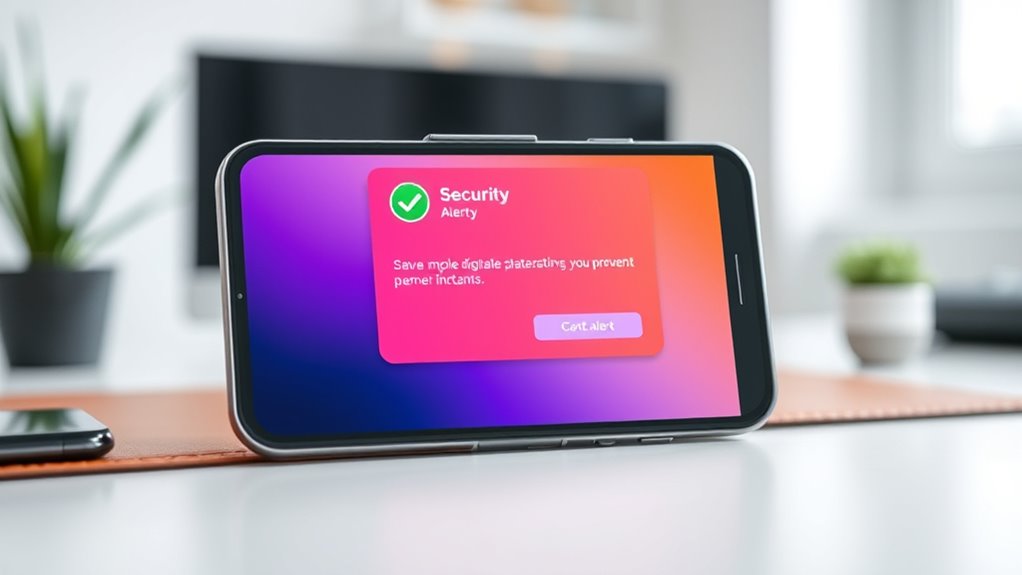
Understanding the alert setting is essential because it helps you stay on top of your bank account activities effortlessly. With alerts, you boost your security awareness by receiving immediate notifications about suspicious or unusual transactions. This proactive approach makes scam detection easier, as you can identify potential fraud early and act swiftly. By setting up alerts for large withdrawals, foreign transactions, or login attempts, you’re better equipped to spot irregularities before they cause significant damage. These timely alerts serve as your first line of defense, giving you peace of mind and strengthening your overall security. Staying informed about account activity through alerts doesn’t just prevent scams—it empowers you to manage your finances confidently and securely. Cookie preferences management can also enhance your security by allowing you to control how your information is used.
How to Enable the Alert Feature in Your Bank Account

To enable alerts, start by locating the alert settings in your bank account online or through the app. Once there, you can customize your notification preferences to suit your needs. This process is straightforward and helps you stay informed about your account activity effortlessly. Be aware that privacy policies outline how your data is managed when using alert features.
Locate Alert Settings
Finding the alert settings in your bank account is usually straightforward. To locate them, start by logging into your online banking portal or mobile app. Once inside, navigate to the security or account settings section. If you’re unsure, customer service can guide you through the process. Here are some key steps to follow:
- Look for a “Notifications” or “Alerts” tab within your account menu.
- Check the “Security Protocols” or “Security Settings” area for alert options.
- Contact customer service if you can’t find the settings or need help enabling alerts.
- Remember that enabling account security features like alerts can help prevent scams and unauthorized transactions.
Customize Notification Preferences
Once you’ve located the alert settings in your account, the next step is to customize your notification preferences. Start by selecting the types of alerts you want, such as large transactions, login attempts, or account changes. This aligns with security best practices by keeping you informed of unusual activity instantly. Make sure your contact details are accurate to receive alerts promptly. Review your notification methods—email, text, or app—and choose the most reliable options. If you encounter any issues or need help tailoring your settings, don’t hesitate to contact customer service contacts for guidance. Customizing your notification preferences enhances your account security and helps prevent scams before they escalate. Staying proactive is key to safeguarding your finances effectively. Understanding security features can empower you to better protect your accounts from unauthorized access.
Recognizing Suspicious Activity Notifications
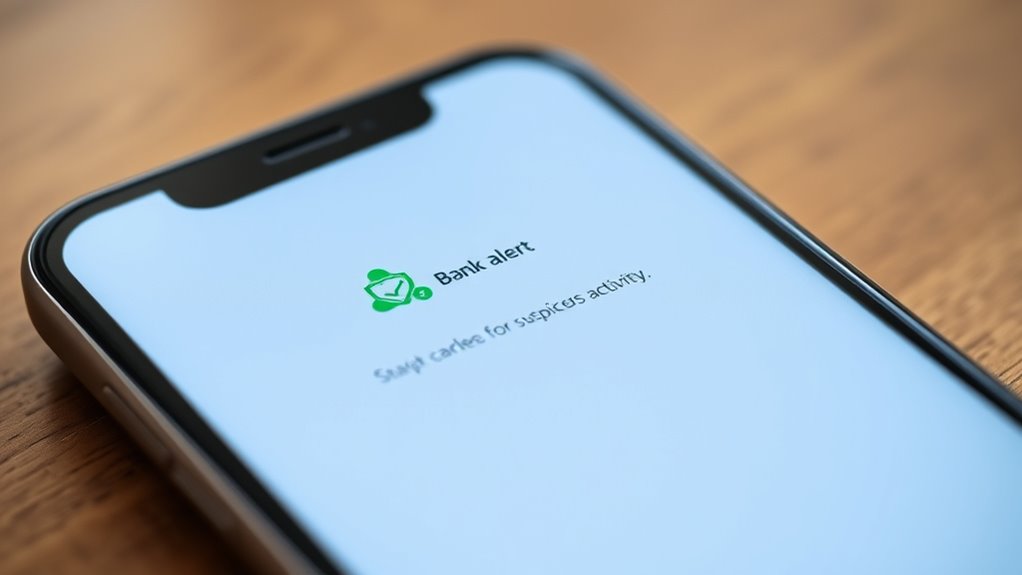
Recognizing suspicious activity notifications is essential for protecting your bank account. These alerts can help you catch early signs of phishing scams or account hacking attempts. When you receive a notification, look for these indicators:
Stay alert to suspicious activity alerts to protect your bank account from scams and unauthorized access.
- Unexpected transactions or unfamiliar merchants
- Login attempts from unknown locations or devices
- Alerts about password changes or account access issues
- Expert voice actors often use immersive soundscapes to create compelling alerts that grab your attention.
If you see any of these, don’t ignore them. These signals often point to someone trying to access your account illegally. Promptly verifying transactions and updating your passwords can prevent scammers from draining your funds or stealing your identity. Staying alert to suspicious activity notifications empowers you to act quickly and protect your financial security before substantial damage occurs.
Real-Life Examples of Scam Prevention Through Alerts
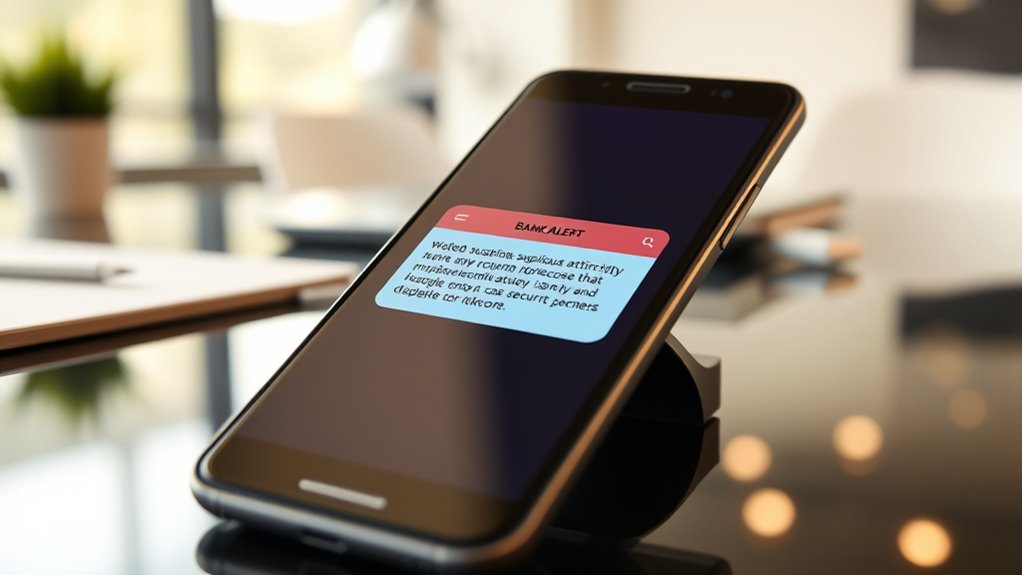
Many people catch scams early thanks to unauthorized transaction alerts that flag suspicious activity. When you respond quickly to these alerts, you can stop fraud in its tracks and prevent further damage. These real-life cases show how setting up alerts can be a powerful tool in protecting your finances. Regularly updating your security settings ensures that your alert system remains effective against evolving scams.
Unauthorized Transaction Alerts
Have you ever received an unexpected alert about a transaction on your bank account? These unauthorized transaction alerts can be lifesavers in fraud detection. They notify you immediately of suspicious activity, helping you act fast. To maximize their effectiveness, consider these key points:
- Verify if the transaction matches your recent activity.
- Contact your bank immediately if you suspect fraud.
- Use alerts as a tool for customer education, understanding common scam tactics.
- Remember that Special Occasions often involve sensitive situations where scams can also target vulnerable individuals.
Such alerts empower you to spot scams early and prevent financial loss. They also reinforce the importance of fraud detection and encourage proactive bank engagement. By setting up these notifications, you stay informed and protect your assets without delay, turning your account into a more secure financial space.
Rapid Response Cases
When you receive an immediate alert about an unusual transaction, it often allows you to act swiftly and prevent potential fraud from escalating. These rapid response cases highlight how alert customization plays an essential role in safeguarding your account security. For example, setting alerts for large or foreign transactions ensures you’re immediately notified of suspicious activity. You might catch unauthorized charges before they cause significant damage, giving you time to freeze your account or contact your bank. Customizing alerts to match your spending habits helps you stay alert to genuine activity and quickly identify anomalies. This proactive approach empowers you to respond effectively, minimizing losses and reinforcing your overall account security. Quick alerts turn reactive measures into preventive actions, stopping scams before they cause harm. Additionally, understanding the contrast ratio of your banking security features can help you better assess and improve your overall fraud protection.
Fraud Prevention Success
Real-life examples show how alert customization can directly prevent scams and unauthorized transactions. When you set up alerts for account verification or fraud monitoring, you’re alerted immediately when suspicious activity occurs. This quick notification allows you to take action before any damage happens. For example:
- A customer received an alert after a large, unusual withdrawal, prompting immediate account verification and stopping theft.
- Alerts flagged multiple login attempts from unfamiliar devices, leading to prompt fraud monitoring and account lockout.
- Real-time notifications helped prevent a scam involving unauthorized wire transfers by confirming legitimate account activity.
- Using dedicated microphones for customer service calls can improve the clarity of alerts and ensure critical messages aren’t missed.
These success stories prove that tailored alerts empower you to catch scams early, protecting your finances and maintaining security.
Tips for Customizing Alert Preferences for Maximum Security
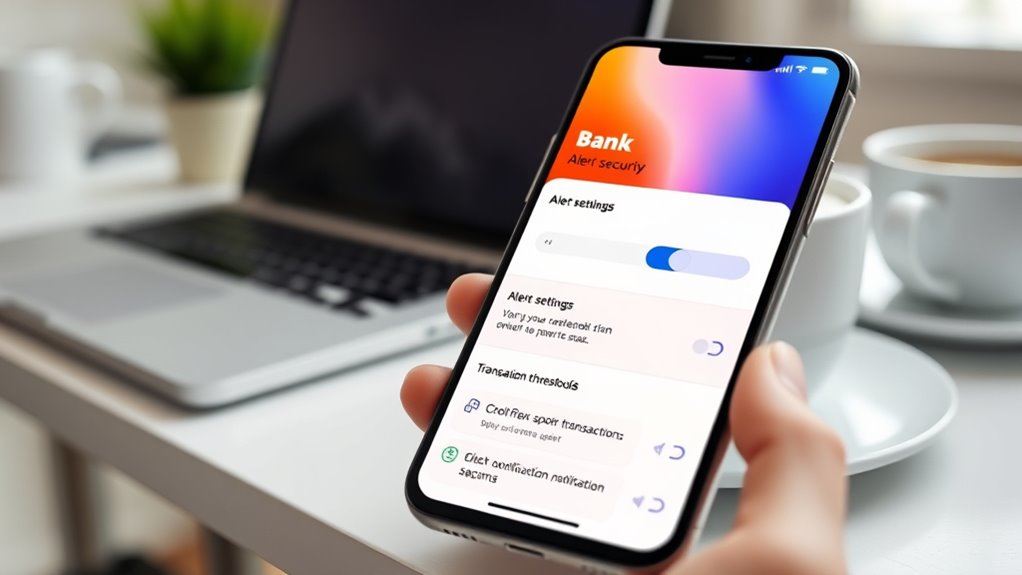
To guarantee your bank account stays secure, customizing your alert preferences is essential. Set alerts for unusual transactions, large withdrawals, or login attempts. This keeps you informed and ready to respond quickly. When adjusting your settings, focus on balancing security with convenience. Use strong password management to prevent unauthorized access, and stay vigilant with phishing awareness—be cautious of suspicious emails requesting personal info. Consider these tips:
| Tip | Benefit |
|---|---|
| Enable real-time alerts | Immediate notification of suspicious activity |
| Customize thresholds | Avoid alert fatigue, focus on critical issues |
| Regularly review alerts | Ensure settings remain aligned with your needs |
Additionally, understanding monitoring tools can help you better interpret alert data and respond appropriately.
Additional Strategies to Protect Your Banking Information

Building on your alert settings, taking additional steps can substantially strengthen your bank security. Implementing proactive measures helps detect and prevent fraud early. Consider these strategies:
Enhance your bank security by actively monitoring accounts, enabling fraud alerts, and updating passwords regularly.
- Enable fraud alerts with your bank to receive instant notifications of suspicious activity.
- Regularly monitor your account statements for unauthorized transactions.
- Use strong, unique passwords for your banking apps and change them periodically.
- Proper rug care techniques can help maintain your belongings and prevent potential security issues with sensitive information.
Frequently Asked Questions
Can I Set Alerts for Specific Transaction Types?
Yes, you can set alerts for specific transaction types through your bank’s transaction customization options. You just need to select the particular transaction categories you want to monitor. You also get to decide alert frequency, so you can choose how often you receive notifications—immediately, daily, or weekly. This flexibility helps you stay informed about important transactions and enhances your security by catching suspicious activity early.
How Often Will I Receive Alert Notifications?
On average, people receive about 4 to 6 alert notifications per week, depending on their transaction frequency. You can customize these alerts to match your activity levels, ensuring you’re not overwhelmed or under-informed. Your alert notifications will arrive promptly after each relevant transaction, helping you monitor your account closely. This way, you stay in control, and your alert customization keeps your alerts perfectly tailored to your banking habits.
Are Alert Settings Available on All Banking Platforms?
Most banking platforms offer alert settings as part of their security features, but availability varies. You can usually customize these options to suit your needs, such as receiving notifications for suspicious transactions or low balances. To guarantee you’re protected, check your bank’s app or website for these customization options. Setting up alerts helps you stay informed and catch potential scams early, giving you greater control over your account security.
What Should I Do if I Miss an Alert?
If you miss an alert, don’t panic—accidents happen. First, check your account activity for any suspicious transactions. Then, perform an alert recovery by updating your contact info and adjusting your alert settings to prevent future misses. Remember, staying vigilant is key. If something seems off, contact your bank immediately to report it. Staying proactive helps protect your finances and keeps you one step ahead of potential scams.
Do Alerts Cost Extra Fees?
Alerts typically don’t cost extra fees, but it’s important to check your bank’s fee structures and alert customization options. Some banks include alert services in their standard account features, while others might charge for premium alerts or additional customization. To avoid surprises, review your bank’s policies and choose alert settings that suit your needs without incurring extra charges. This way, you stay informed without unexpected costs.
Conclusion
Think of your bank alert as a vigilant lighthouse, guiding you safely through treacherous waters. By setting it up, you’re shining a light on potential dangers before they reach you, preventing scams from sinking your financial ship. With these alerts, you stay one step ahead, steering confidently through your banking journey. So, activate your lighthouse today—your financial safety depends on it, and peace of mind is just a click away.
